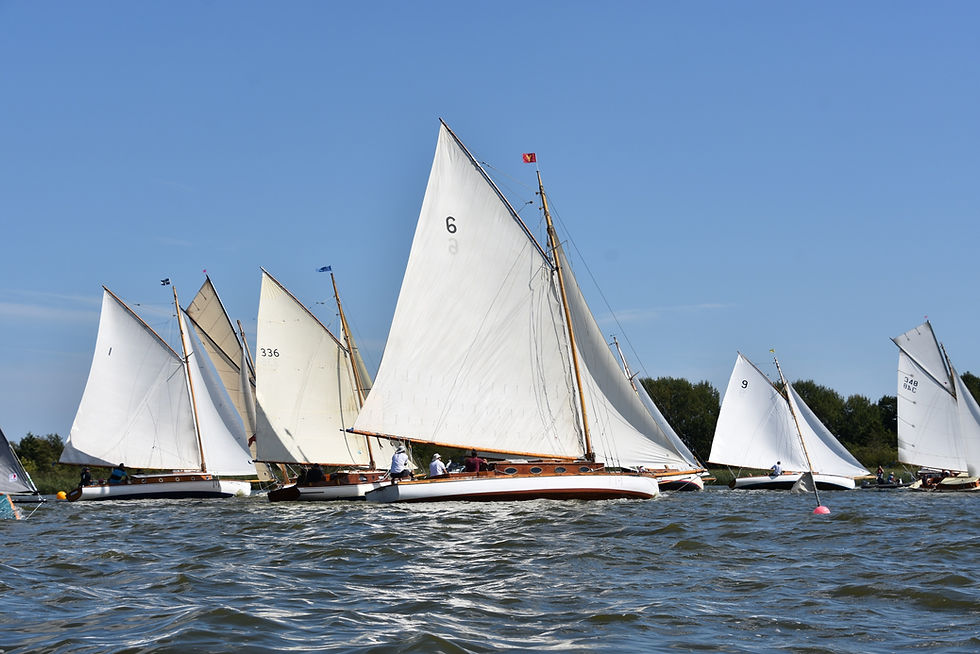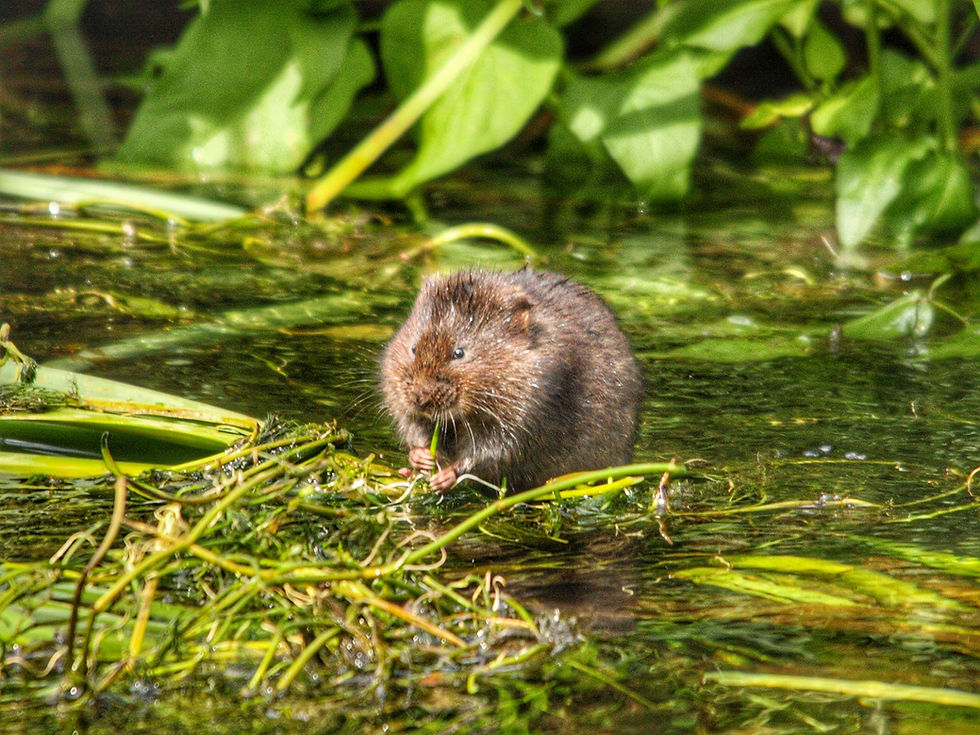NAVIGATION AND THE BROADS
- broadssociety
- Mar 7, 2024
- 7 min read
The Broads have a distinguished heritage in maintaining navigation. It’s the only member of the national park family that has such a long, navigable and tidal inland waterway running through it, which is why the Broads were late to the party in getting full UK protection status. In fact, an international treaty, the Ramsar Convention on Wetlands of International Importance, led the way, listing parts of the Broads way back in 1971.
Later on, the Broads were protected under the Norfolk & Suffolk Broads Act 1988, extended and clarified by the Broads Authority Act, 2009. The title “Broads National Park”, adopted by the Broads Authority in 2015 for promotional purposes, recognised the area’s equivalent credentials and special qualities, but also clearly emphasised the importance of the navigation.
The right to navigate the 200km of waterway in the Broads is enshrined in law, but interest goes beyond legalities, associated boat tolls and the boating infrastructure. Boating in all its forms is integral to the ecology and landscape of the Broads, keeping the waterways open and biologically diverse. Pressure groups often present the boating community as separate and distinct from other Broads users but in truth, everything in the landscape is connected and important for the well-being of non-boating users and visitors in many similar ways. We need to set aside narrow agendas and join forces to address shared objectives like preventing floods, protecting the navigation from sea-level rise, and halting biodiversity loss. (see “Biodiversity, Boating. and the Broads” Harnser January 2023, 34-36).

For more than a century, recreational boaters have enjoyed the peaceful, semi-natural Broads landscape. About 11,000 private, and more than 1000 hire boats use the waterways, and boaters make up a high proportion of the 7.5 million visitors welcomed annually. In FY 2021/22, private boat owners paid £2.4M in tolls and hire boats £1.2M, in sum together with other income of £3.7M, somewhat exceeding the Defra National Park grant of £3.4M. Tolls pay to keep the traditional navigation accessible, safely marked, and with good facilities for launching and mooring. It’s an expensive, challenging, and open-ended task for the Broads Authority, only achieved by constantly dredging silt and controlling the growth of water plants. Moreover, it must be done in consultation with Natural England so as not to impact biodiversity. The onus of responsibility is increasing as climate warming impacts the navigation and the biodiversity crisis deepens. The maintenance work has to be prioritised and carefully targeted.
As the flooding predictions of the Broadland Futures Initiative become reality, boat owners can see the problems they face. Floods threaten clubhouses, moorings, and favoured sailing haunts, as well as wildlife. Sea levels have already risen by 15cm due to climate warming and the average annual rise of 3.6mm per year is increasing year on year. More frequent storms and surges impact infrastructure and boats. The air draft at Potter Heigham Bridge on the River Thurne is now less than 2m and larger craft have been unable to transit for some time. The same is happening at Ludham Bridge and Wroxham Bridge. All too soon boats will struggle to make passage under the bridges at Great Yarmouth, St Olaves and Beccles. Threats to our navigation options are beginning to take centre stage.
Everyone who uses the Broads for navigation will have their own ideas about what improvements are needed, and we in the Broads Society would love to hear your thoughts. Here are some examples of ways in which we suggest the navigation could be improved.
1. BETTER ACCESS TO THE BROADS FROM THE SEA
Recreational navigation interests are not confined to the Executive Area of the Broads Authority. The ports of Great Yarmouth and Lowestoft are key access points for visitors and tourists as well as exit points for residents and boaters travelling further afield. There are many ways in which these ports could be made more welcoming for visitors to the Broads from overseas. Great Yarmouth is a notoriously difficult and dangerous place for small boats needing to moor. The new waiting moorings at Herring Bridge are most welcome, but the riverside signage should be relocated out of the way of the masts and rigging that trail behind demasted boats.

Town Hall Quay, on the opposite bank, is the responsibility of Great Yarmouth Borough Council and presents the recreational skipper, who is often transiting during slack low tide, with a forbidding steel wall, and no pontoons or mooring points to help boats stand off. There is great potential for this quay to have user-friendly infrastructure to welcome visitors to the Broads.
Peel Ports Group, who run Great Yarmouth harbour, recently announced charges for all craft entering or exiting Great Yarmouth. The Broads Society, along with other representatives in the Port Leisure Users Group, find these charges unwelcome when facilities are so poor.
2. BETTER MOORINGS ON BREYDON WATER
Breydon Water is rough at stormy times of the year, and permanent moorings are confined to “dolphins” comprised of three vertical posts welded together by struts. This arrangement offers swing moorings, but they are poorly fendered and unpopular. On Breydon’s south bank, near the Breydon Bridge, is a large commercial jetty managed by the Department of Transport, but it has not been used in many years, and now that the Broads Authority has recently cancelled pilotage services, this is unlikely to change. This jetty could be adapted for recreational boating between Easter and October by fitting a temporary floating pontoon that would be removed to sheltered winter storage at the end of the season. The Broads Authority has approached the Department for Transport with this idea in the past, and been rebuffed, but now that commercial traffic is unlikely to return, the decision could be revisited.

Many people think that temporary or permanent pontoons should be used more widely on the Broads. They are a lot cheaper than hard quay headings, more environmentally friendly because soft riverbanks can be retained, and safer, as boats tied to them do not get hooked up. A good example of pontoon moorings is the Dutch Tea Gardens mooring on the River Waveney/Oulton Dyke.
3. ELECTRONIC HEIGHT GAUGES ON BREYDON
For improved safety of boats crossing Breydon Water from the Yare and Waveney towards the Bure, electronic height gauges at Berney Arms and Burgh Castle informing skippers of the clearance at the upcoming bridges on the River Bure would be very helpful. This idea was proposed by the Broads Authority several years ago but never implemented.
4. A WIDER NAVIGATION CHANNEL AT HICKLING BROAD
Hickling is the largest of all the Norfolk broads and consists mainly of open water, with extensive fringing reedbeds, marshes and some woodland. It is home to many rare and protected plants, insects, birds and mammals, but also has a long heritage of human use, formerly for fuel-gathering and duck shooting, and nowadays for its recreational navigation, natural history and footpaths. It is the base for a commercial boat hire and excursion industry as well as for several water sports clubs.

Hickling is the head of navigation in this tributary, but craft heading for the Upper Thurne come up against three challenges: the abundance of water plants, shallow water, and the low bridge at Potter Heigham. These constraints mean loss of business for commercial boatyards, fewer dinghy and paddle-board sailors, very few visits by motor cruisers and less interest from organisers of regattas. Pilotage at Potter Heigham Bridge, which would at one time have aided more than 3000 boats every year, now provides none. Water plants tangling with propellers, rudders and keels cause damage and costly rescue callouts. The overall effect is a loss to the local economy and reduced access for recreational visitors (see “Hickling Broad” Harnser October 2022: 11-15).
The Broads Society is campaigning to ease the Natural England licence for water plant management at Hickling, such that the cut channel could be enlarged, enabling a return to commercial boating services from Whispering Reeds and other boatyards, and a full dinghy racing programme at Hickling Broad Sailing Club. Access to Hickling Broad for the general public would be much improved through this initiative.
5. MORE MARINAS
Marinas have declined in the Southern Rivers for some years, and it has become increasingly difficult for boat owners and holiday-makers to find the entertainment, repair, fuel and pump-out facilities they need here. Meanwhile, the Northern Rivers, with attractive honeypots like Wroxham, access to attractive village pubs and restaurants, and wide-ranging opportunities to see the Broads landscape at its best, are becoming congested at peak holiday times. The proposed new marina developments at Stalham and Acle could provide a welcome boost to the local economy, and it would be good to see similar initiatives in the Southern Broads too. Of course, any new development must be sustainable, not only in terms of the Broads heritage but also for carbon balance and biodiversity benefits. The Broads Society provides comments and recommendations on all major planning applications in the Broads.

6. SAFER PADDLEBOARDING
Many boat-owners worry that users of paddle boards have little knowledge of the rules of the river and are concerned that there could be a serious accident before long. The sport is increasingly popular, and while acknowledging that efforts are being made, more information and training opportunities are needed from sailing clubs, hire companies and the Broads Authority. There is also an argument for identifying areas well-suited for paddle-boarding and marking them accordingly.
The Broads Society's efforts in conservation, advocacy, and community engagement are essential to protecting this important part of our lives. Joining the Society is not just a way to support their efforts; it's an opportunity to be part of a community that is deeply committed to the stewardship of one of the UK's most precious natural landscapes. Whether you are a local resident, a frequent visitor, or someone who holds the Broads dear, becoming a member of the Broads Society is a meaningful way to contribute to the preservation and enhancement of this unique area.




Comments